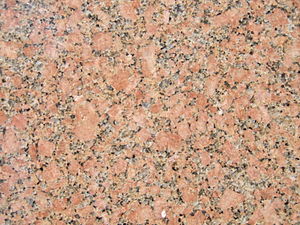Term: Granite
**Granite Composition and Formation**:
– Granite is a coarse-grained intrusive igneous rock composed mainly of quartz, alkali feldspar, and plagioclase.
– The chemical composition of granite includes 72.04% silica, 14.42% alumina, and varying amounts of other elements.
– Granites are classified based on their mineral composition and percentages of quartz, alkali feldspar, and plagioclase.
– Granite forms from silica-rich magmas known as felsic magmas, which can be influenced by processes like fractional crystallization.
– True granites contain between 20% and 60% quartz by volume and are named based on the QAPF diagram for coarse-grained plutonic rocks.
**Occurrence and Geological Features of Granite**:
– Granitic rocks are widely distributed throughout the continental crust and are commonly found in igneous intrusions ranging from dikes to batholiths.
– Most granites were intruded during the Precambrian age and underlie the sedimentary veneer of continents.
– Granites occur in various forms like tors, domes, bornhardts, and rounded massifs, and are associated with orogenic mountain ranges.
– Granites are found in stock masses, batholiths, and may occur with pegmatite masses in some locations.
– The origin of granites can vary, with some forming from felsic magmas and others from fractional crystallization of basaltic magma.
**Uses and Significance of Granite**:
– Granite is widely used in construction for its hardness, toughness, and durability, making it suitable for various applications.
– Ancient civilizations like the Egyptians and Romans used granite in monumental architecture, temples, and pyramids.
– Modern uses of granite include countertops, flooring, monuments, sculptures, and road construction materials.
– Granite has cultural and historical significance, being present in structures like Buddhist shrines, medieval temples, and historical monuments worldwide.
– The granite industry is one of the oldest in the world, with major exporters including China, India, Italy, and the United States.
**Granite Weathering and Environmental Impact**:
– Granite undergoes physical and chemical weathering processes, leading to the formation of grus and influencing soil development.
– Weathering of granite can produce radon gas, which poses health risks when accumulated indoors.
– Some granites contain radioactive elements like uranium and thorium, impacting indoor air quality and potentially leading to lung cancer.
– Granite quarrying and processing can have environmental impacts, including habitat destruction and emissions of low levels of radiation from countertops.
– Climatic variations can influence the rate of granite weathering, affecting its longevity and permeability in pavements.
**Engineering and Industrial Applications of Granite**:
– Granite is extensively used in public and commercial buildings, with notable examples in Aberdeen, Scotland, and New England.
– In engineering, granite is used for surface plates, concrete substitutes, slabs, boulders for military purposes, and tramway tracks.
– The granite industry has evolved with modern cutting and carving methods, including computer-controlled tools and sandblasting techniques.
– Granite is used for paving due to its durability, low maintenance requirements, and permeability, commonly seen in urban settings.
– Granite’s engineering applications extend to the production of curling stones, rock climbing venues, and various industrial uses worldwide.
Granite (/ˈɡrænɪt/ GRAN-it) is a coarse-grained (phaneritic) intrusive igneous rock composed mostly of quartz, alkali feldspar, and plagioclase. It forms from magma with a high content of silica and alkali metal oxides that slowly cools and solidifies underground. It is common in the continental crust of Earth, where it is found in igneous intrusions. These range in size from dikes only a few centimeters across to batholiths exposed over hundreds of square kilometers.
| Igneous rock | |
 | |
| Composition | |
|---|---|
| Classification | Felsic |
| Primary | potassium feldspar, plagioclase feldspar, and quartz |
| Secondary | Differing amounts of muscovite, biotite, and hornblende-type amphiboles |
Granite is typical of a larger family of granitic rocks, or granitoids, that are composed mostly of coarse-grained quartz and feldspars in varying proportions. These rocks are classified by the relative percentages of quartz, alkali feldspar, and plagioclase (the QAPF classification), with true granite representing granitic rocks rich in quartz and alkali feldspar. Most granitic rocks also contain mica or amphibole minerals, though a few (known as leucogranites) contain almost no dark minerals.

Granite is nearly always massive (lacking any internal structures), hard, and tough. These properties have made granite a widespread construction stone throughout human history.
